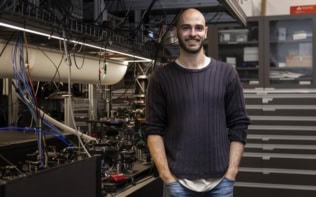Physicists in Germany have discovered that 60 appears to be the minimum number of helium-4 atoms needed for superfluidity to occur in liquid helium. The team obtained evidence for the superfluidity by studying droplets of liquid helium-3 and helium-4. Droplets of pure helium-3 showed no evidence for superfluidity, but the addition of 60 atoms of helium-4 lead to the observation of superfluid behaviour.
Bulk superfluid helium has many unusual properties – it can flow up walls and through narrow pores without resistance. Helium-4 and helium-3 become superfluid below 2.12 and 0.003 Kelvin respectively. However, only a proportion of the helium becomes superfluid at the transition temperature. This two-fluid model was confirmed experimentally by Andronikashvili in the mid-1940s. The latest experiments are microscopic versions of the Andronikashvili experiment.
The researchers used infrared absorption to measure the rotational spectra of oxygen carbon sulphide (OCS) molecules in small clusters of liquid helium. Narrow rotational lines imply free rotation of the molecules and hence superfluidity in the helium. 60 helium atoms are enough to coat the OCS molecule with two layers of atoms. This number of atoms is also in reasonable agreement with theoretical predictions.
In a paper published in this week’s Science magazine the researchers – Slava Grebenev, Peter Toennies and Andrei Vilesov of the Max Planck Institute for Fluid Dynamics in Göttingen – suggest that the effect should be called “molecular superfluidity.”



